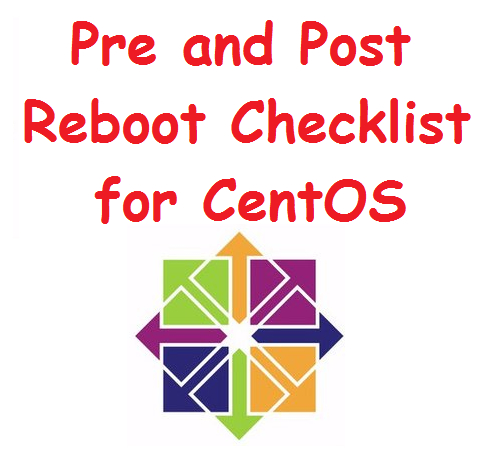As a system administrator or IT professional, managing a CentOS server is a crucial part of ensuring that your organization’s technology infrastructure runs smoothly. However, server maintenance can be a daunting task, especially when it comes to rebooting a server. Rebooting is an essential part of server maintenance, but it can lead to unexpected issues if not done properly. To ensure a successful reboot, it’s important to follow a pre-reboot and post-reboot checklist. In this blog, we will discuss an essential pre-reboot and post-reboot checklist for CentOS server maintenance.
Essential Pre-Reboot and Post-Reboot Checklist for CentOS Server Maintenance
Pre-Reboot Checklist for CentOS Server
Verify System Uptime:
Before rebooting your CentOS server, it’s important to verify the system uptime. The uptime is the amount of time the system has been running since the last boot. By checking the uptime, you can ensure that the server has been running smoothly without any issues.
To check the system uptime, run the uptime command in your terminal. The output will show you the current time, how long the system has been running, the number of users logged in, and the system load averages for the past 1, 5, and 15 minutes.
Check System Resources:
Checking system resources is crucial to avoid any possible problems after rebooting. It’s essential to ensure that the server has enough resources available to function correctly after the reboot. You can check the system resources like CPU usage, memory usage, and disk usage to determine if any resources are overutilized or underutilized.
To check system resources, use the top or htop command in your terminal. The output will show you the current CPU usage, memory usage, and other system resources.
Check Running Services:
Before rebooting the server, you need to check which services are running on your CentOS server. Verify that they can be stopped and started without any issues. Some services may not start up automatically after the reboot. Therefore, it’s important to verify the services’ status before rebooting.
To view the running services, use the systemctl command in your terminal. The output will show you the status of all the running services on the server.
Check System Logs:
Reviewing system logs is essential to ensure there are no errors or warnings that could cause issues after rebooting. System logs are files that contain information about system events, such as warnings, errors, and alerts. Reviewing these logs can help you identify potential issues that could cause problems after rebooting.
To check system logs, use the journalctl or tail -f command in your terminal. The output will show you the most recent log entries.
Backup Data:
Before rebooting the server, it’s essential to create a backup of your important data. Backing up your data ensures that you can restore your data in case anything goes wrong during or after the reboot. It’s crucial to ensure that your backup is complete and that you can restore it without any issues.
Post-Reboot Checklist for CentOS Server
Verify System Uptime:
After rebooting the server, verify that the system uptime has reset to zero. Ensure that there are no unexpected issues or errors after rebooting the server. If there are any issues, take the necessary steps to fix them.
Check System Resources:
Once the server is back up, check the system resources again to ensure they are functioning normally. Verify that the CPU usage, memory usage, and disk usage are within normal ranges. If there are any issues, take the necessary steps to fix them.
Check Running Services:
After rebooting, verify that all the necessary services are running. Make sure that there are no errors in the logs. Ensure that the services are running correctly and that they are starting up automatically after the reboot.
Check System Logs:
Review system logs again after the reboot to ensure there are no errors or warnings. If there are any errors or warnings, investigate and resolve them as soon as possible. It’s crucial to ensure that the server is running smoothly after the reboot.
Perform Security Updates:
After rebooting the server, it’s important to ensure that the system is up-to-date with the latest security updates. Check for any available security updates and install them as soon as possible. Security updates can help protect the server from known vulnerabilities and ensure that it’s more secure.
To check for available updates, use the yum update command in your terminal. The output will show you any available updates, and you can choose to install them.
Test Server Functionality:
After completing the above steps, it’s essential to test the server’s functionality to ensure everything is working as expected. Check that all services are running and that they are accessible. Test any applications or systems that rely on the server to ensure they are functioning correctly.
Document Changes:
After rebooting the server and completing all the necessary steps, it’s important to document any changes made. This documentation can include any updates, changes to services, or system modifications. This documentation can help you in the future when troubleshooting any issues or in case there is a need to restore the server to a previous state.
Checkout commands for Pre and Post Linux Reboot
Conclusion:
Rebooting a CentOS server is an essential part of server maintenance. However, it can lead to unexpected issues if not done correctly. Following the above pre-reboot and post-reboot checklist can help you ensure that the server is running smoothly and without any issues. By verifying the system uptime, checking system resources, reviewing system logs, performing security updates, and testing server functionality, you can ensure that your CentOS server is functioning optimally. Additionally, documentation of changes can help you troubleshoot any issues or restore the server to a previous state. By following these essential steps, you can ensure that your CentOS server is functioning optimally and without any issues.










